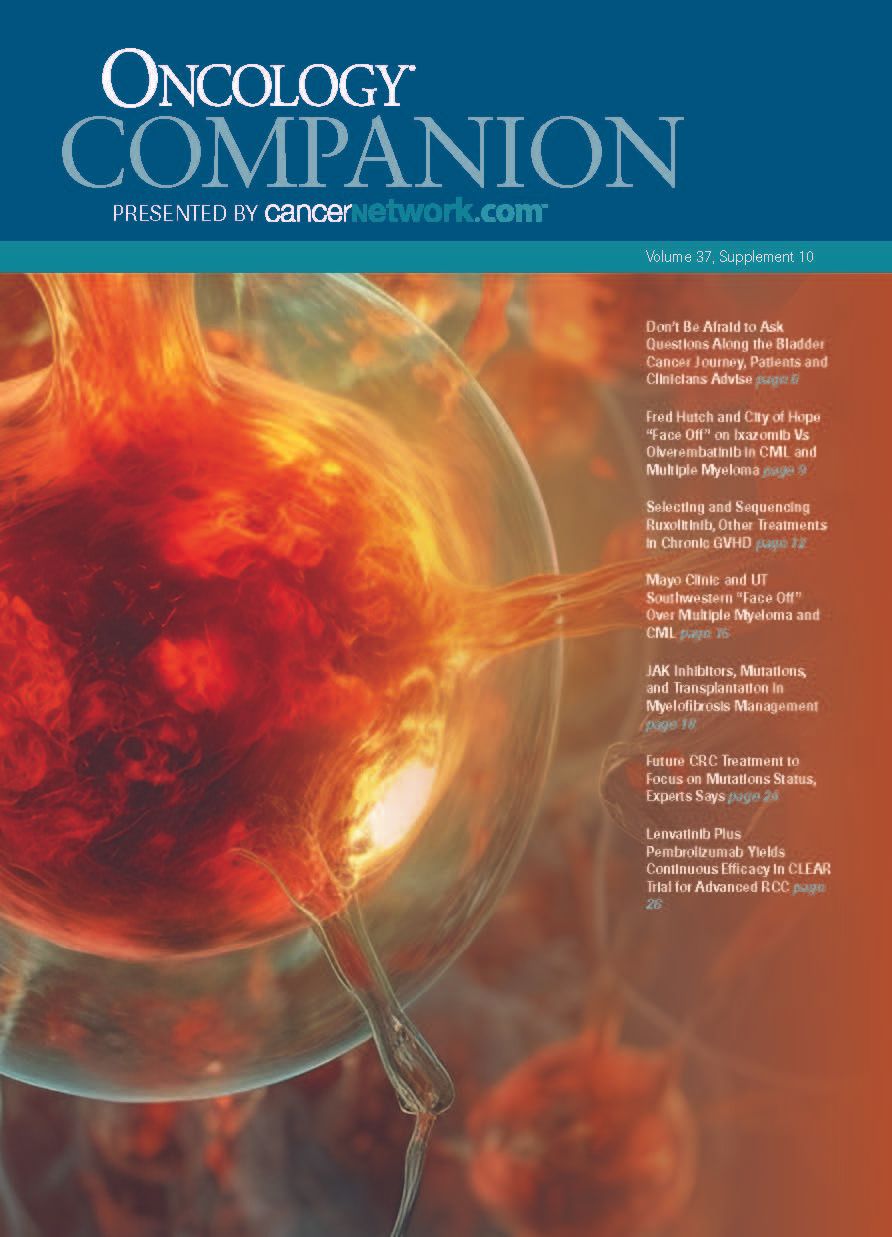Lenvatinib Plus Pembrolizumab Yields Continuous Efficacy in CLEAR Trial for Advanced RCC
Brian I. Rini, MD, led a panel where he and his colleagues discussed the results of the CLEAR trial and its implications in renal cell carcinoma.
The panel discussed the phase 3 CLEAR trial (NCT02811861).

During the 2023 Kidney Cancer Research Summit, experts in the field gathered to discuss new research techniques and regimens that are affecting the standard of care. Most prominently featured was the 4-year follow-up from the phase 3 CLEAR trial (NCT02811861) assessing lenvatinib (Lenvima) and everolimus (Afinitor) or lenvatinib and pembrolizumab (Keytruda) vs sunitinib (Sutent) in patients with advanced renal cell carcinoma (RCC).1
Based on previously presented results from the trial, the FDA approved the use of lenvatinib plus pembrolizumab for patients with advanced RCC in August 2021.2 The 1069 patients who were treatment naïve, were randomly assigned 1:1:1. The dosing regimen can be found in the Figure.
Figure. Arms in the CLEAR Trial

The analysis presented at the conference focused on results from the lenvatinib/pembrolizumab arm vs sunitinib. Regarding baseline characteristics, patients were categorized by complete response (CR; n = 65), overall partial response (PR; n = 188), PR with 75% or more tumor reduction (near CR; n = 59), PR with 50% or more and less than 75% tumor reduction (n = 84), and PR with 30% or more and less than 50% tumor reduction (n = 45). Across the International Metastatic RCC Database Consortium (IMDC), patients with CR, near CR, or PR had similar characteristics.
The objective response rate per independent review in the combination arm was 71.3% (95% CI, 66.6%-76.0%) vs 36.7% (95% CI, 31.7%-41.7%) in the sunitinib arm (relative risk, 1.94; 95% CI, 1.67-2.26). In the combination arm, the PR rate was 53.0%, the stable disease rate was 18.9%, the CR rate was 18.3%, and the progressive disease rate was 5.4%.
Tumor response was assessed by IMDC at baseline in the lenvatinib/pembrolizumab arm. Favorable risk and intermediate risk were assessed for those with a CR (38.5% vs 61.5%), PR (27.1% vs 72.3%), near CR (33.9% vs 64.4%), PR with 50% or more and less than 75% tumor reduction (29.8% vs 70.2%), and PR with 30% or more and less than 50% tumor reduction (13.3% vs 86.7%), respectively.
Among responders, the median duration of response (DOR) was
26.7 months (95% CI, 22.8-34.6) in the combination arm and 14.7 months (95% CI, 9.4-18.2) in the sunitinib arm. The median overall survival (OS) for patients with a CR or near CR was not reached, and those with a PR with 30% or more and less than 50% tumor reduction had a median OS of 46.3 months (95% CI, 39.5-not evaluable).
The median time to first dose reductions for patients in the combination arm included 3.12 months for those with CR, 2.12 months for those with PR with 30% or more and less than 50% tumor reduction, 2.22 months for those with PR with 50% or more and less than 75% tumor reduction, and 1.87 months for those with near CR. For patients who achieved a CR, the median duration of treatment was 36.5 months, 26.6 months for those with a near CR, and 23.8 months for those with a PR.
Motzer: The long-term follow-up of the CLEAR trial that we reported dovetailed out of the more definitive analysis—the final prespecified OS analysis that was presented by Thomas E. Hutson, DO, at the American Society of Clinical Oncology [ASCO] in June 2023.3 It was confirmatory and reassuring of the extraordinary efficacy that we see with this [trial]. The response rate for these patients is [more than] 70% and is the highest response rate we’ve ever seen with any [trial] in RCC. The median duration of progression-free survival was almost 24 months.
The survival benefit was reassuring. People have focused on the changing [HR]. That reflects a subsequent therapy and availability to immunotherapy therapy for the second and third lines, as well. The fact is that it’s not the primary analysis of survival. The response rate is amazing, with [response rates] of almost 20%, many of which are durable. It speaks to the high level of efficacy for this [trial] and for the particular approach overall for tyrosine kinase inhibitor/immunotherapy [regimens] and first-line therapy for RCC.
Rini: We showed some of the [DOR] numbers. In those with a CR, it was [approximately] 44 months and then decreases as you have less tumor shrinkage. What do you think of the numbers? Is that something you’d talk to patients about? How are you going to use [those data]?
Plimack: That’s still the most compelling number of the CLEAR trial, the very low rate of patients who progressed right through it. Achieving that level of control—stable disease included—is important. One of the most compelling hallmarks of this regimen is the approach overall; in terms of durability, there’s continued response. There [are some] holding on to the response, and [there are a few] losing the response but staying on therapy and meeting overall control. There’s the best-case scenario where you can stop the drugs and continue disease control off therapy. Those are all different versions of the [DOR], all of which are good places to be for patients.
It is hard to speak for the patient in front of you in terms of their chances of reaching [a response]. It’s balanced with the toxicity they may experience over time. In general, I give the strongest regimen [for] the best chance of response, manage, treat for efficacy, manage for toxicity, and give patients the hope that there is [the possibility of response. The combination has a] high seizure rate here and some durable scores with PRs that are prolonged. Patients with stable disease can do well for a long time.
Rini: Is there anything about the earlier update from ASCO that wasn’t covered? [Have any of these results] changed your mind in your approach to patients? The broader question is: Do you think it changed anybody’s mind? If they were doing regimen X before, did they see these updates and now do regimen Y?
Ornstein: The updates from both CLEAR and the phase 3 KEYNOTE-426 [NCT02853331] [trial], more than anything else, were just reassuring.4 One of the questions in the field is always going to be, and has been for a while, with the [first line of treatment] regimens: Is the benefit only up front, or is there a sustained benefit? Is there durability of response? We’re starting to see a couple of years out now with the additional follow-up that the response that was seen up front [contains] durability for subsets of patients.
I am intrigued by the depth of response data and their association here in the CLEAR study, both with the [DOR] and with OS. Now, a couple of years ago, I may have told patients that if [they achieve] stable disease, that’s good, efficient, OK. Now I’m looking at their disease and the tumor burden reductions and taking that more into consideration as I counsel them. It has taught us that a better response and more tumor shrinkage are better overall for an individual patient. In general, it’s better to have a deeper response with more tumor burden shrinkage. It has also told us that you don’t necessarily need a CR.
On the one hand, it has told us [we] want more tumor burden shrinkage. On the other hand, it was patients who had at least a 75% tumor burden reduction that fared similarly to the patients who had a CR. I don’t think it’s changed anybody’s mind. It has been reassuring just to see the additional follow-up, and I do use the extent of response in terms of the depth of response to help guide patients.
References
- Motzer RJ, Powles T, Hutson T, et al. Characterization of tumor response with lenvatinib plus pembrolizumab in patients with advanced renal cell carcinoma: final overall survival analysis of the CLEAR study (4-year median follow up). Presented at: 2023 Kidney Cancer Research Summit; July 13-14, 2023; Boston, MA. Abstract 66.
- FDA approves lenvatinib plus pembrolizumab for advanced renal cell carcinoma. FDA. August 10, 2021. Updated August 11, 2021. Accessed August 28, 2023. https://bit.ly/3EKRUFe
- Motzer RJ, Porta C, Eto M, et al. Final prespecified overall survival (OS) analysis of CLEAR: 4-year follow-up of lenvatinib plus pembrolizumab (L+P) vs sunitinib (S) in patients (pts) with advanced renal cell carcinoma (aRCC). J Clin Oncol. 2023;41(suppl 16):4502. doi:10.1200/JCO.2023.41.16_suppl.4502
- Rini BI, Plimack ER, Stus V, et al. Pembrolizumab plus axitinib versus sunitinib as first-line therapy for advanced clear cell renal cell carcinoma: 5-year analysis of KEYNOTE-426. J Clin Oncol. 2023;41(suppl 17):LBA4501. doi:10.1200/JCO.2023.41.17_suppl.LBA4501
EP: 1.Data From KCRS 2023: The CLEAR and TRAVERSE Studies in Advanced Clear Cell RCC
EP: 2.Advanced Clear Cell RCC: Impact of the CLEAR Trial on Real-World Practice
EP: 3.Selecting Frontline Therapy for Patients With Advanced Clear Cell RCC
EP: 4.Factors Aiding in the Selection of Frontline Therapy in Advanced Clear Cell RCC
EP: 5.Updates from ASCO 2023: KEYNOTE-B61 Study in Non-Clear Cell Renal Cell Carcinoma
EP: 6.Non-Clear Cell Renal Cell Carcinoma: Interpreting Data With IO/TKI Combination Therapies
EP: 7.Chromophobe RCC and Papillary Kidney Cancer: Novel Treatment Strategies
EP: 8.Frontline IO-Based Regimens in Sarcomatoid or Rhabdoid Metastatic nccRCC
EP: 9.Evolving Treatment Landscape of RCC: Future Directions in Care
EP: 10.Lenvatinib Plus Pembrolizumab Yields Continuous Efficacy in CLEAR Trial for Advanced RCC
